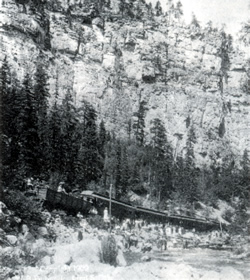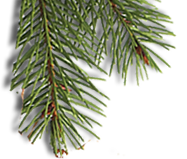
During the last part of the nineteenth century, and until 1933, trains provided most of the travel in the Canyon.
|
|
In 1897, the Canyon was included as part of the Black Hills National Forest –called Reserve, then).
In this area, creek bank plants of a shrubby willow variety, primarily Bebb Willow, and Oak and Elm trees mark Easter Deciduous Forest influence more commonly found 400 miles east.
Beginning at the Canyon’s mouth, near Spearfish, to Interpretive Stop 15.5, grasses, a variety of broad-leafed flowering plants, trees and shrubs, occurring on mainly north slopes or in draws, mark Northern Great Plains vegetative influence.
A great number of bird species may be found south of this stop, where the water flows in Spearfish Creek. Active times for most birds are dawn and dusk, but smaller birds, like the Chickadees, feed almost constantly and larger ones, such as the Eagle, may feed only once or twice a day. |


